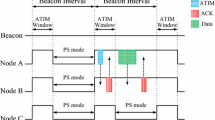Abstract
Quorum System is a good method to assist the design of sensors of the wake-up scheduling mechanism. However, there are some problems about idle rendezvous and poor link quality when the sensor performs a sensing task according to the Quorum System. In order to improve the efficiency of the sensors and reduce energy consumption, a new rendezvous mechanism is proposed. The use of energy and the link quality between sensors are considered from a global perspective. It can not only ensure the rendezvous opportunity among sensors, but also balance the residual energy of the sensors, so it can improve the energy-saving efficiency of traditional Quorum System. According to the simulation, compared with the traditional Quorum System scheduling mechanism, the rendezvous mechanism proposed in this paper can effectively reduce the number of time-slots when the sensor is idle. Moreover, it also realizes the balance of the residual energy of the sensor and the link quality, which prolongs the life cycle of the wireless sensor network and improves the communication quality.
Similar content being viewed by others
References
Yang Q, He S, Li J, et al. Energy-Efficient probabilistic area coverage in wireless sensor networks[J]. IEEE Transactions on Vehicular Technology, 2015, 64(1): 367–377.
Wu S, Niu J, Chou W, et al. Delay-Aware energy optimization for flooding in duty-cycled wireless sensor networks[J]. IEEE Transactions on Wireless Communications, 2016, 15(12): 8449–8462.
Akhtar F, Rehmani M H. Energy replenishment using renewable and traditional energy resources for sustainable wireless sensor networks: A review[J]. Renewable & Sustainable Energy Reviews, 2015, 45: 769–784.
Yao Y, Giannakis G B. Energy-Efficient scheduling for wireless sensor networks[J]. IEEE Transactions on Communications, 2015, 53(8): 1333–1342.
Zen K, Javed M, Lenando H B, et al. Intelligent coordinator selection mechanism (ICSM) for IEEE802.15.4 Beacon-Enabled MAC protocol in mobile wireless sensor networks[J]. International Review on Computers and Software, 2015, 10(2): 164.
Lai S, Ravindran B, Cho H. Heterogenous quorum-based wake-up scheduling in wireless sensor networks[J]. IEEE Transactions on Computers, 2010, 59(11): 1562–1575.
Chao C M, Lee Y W. A quorum-based energy-saving MAC protocol design for wireless sensor networks[J]. IEEE Transactions on Vehicular Technology, 2010, 59(2): 813–822.
Own C M, Meng Z, Liu K. Handling neighbor discovery and rendezvous consistency with weighted quorum-based approach[J]. Sensors, 2015, 15(9): 22364–22377.
Zhang D, He T, Ye F, et al. EQS: Neighbor discovery and rendezvous maintenance with extended quorum system for mobile sensing applications[C]//IEEE International Conference on Distributed Computing Systems. Washington D C: IEEE, 2012: 72–81.
Ekbatanifard G H, Monsefi R, Yaghmaee M H, et al. Queen-MAC: A quorum-based energy-efficient medium access control protocol for wireless sensor networks[J]. Computer Networks, 2012, 56(8): 2221–2236.
Muruganathan S D, Ma D C F, Bhasin R I, et al. A centralized energy-efficient routing protocol for wireless sensor networks[J]. IEEE Communications Magazine, 2005, 43(3): S8–13.
Hou Y T, Shi Y, Sherali H D, et al. On energy provisioning and relay node placement for wireless sensor networks[J]. IEEE Transactions on Wireless Communications, 2005, 4(5): 2579–2590.
Sohn I, Lee J H, Sang H L. Low-Energy adaptive clustering hierarchy using affinity propagation for wireless sensor networks[J]. IEEE Communications Letters, 2016, 20(3): 558–561.
Tsai C H, Hsu T W, Pan M S, et al. Cross-Layer, energy-efficient design for supporting continuous queries in wireless sensor networks: A quorum-based approach[J]. Wireless Personal Communications, 2009, 51(3): 411–426.
Ahmed N, Kanhere S S, Jha S. On the importance of link characterization for aerial wireless sensor networks[J]. IEEE Communications Magazine, 2016, 54(5): 52–57.
Author information
Authors and Affiliations
Corresponding author
Additional information
Foundation item: Supported by the Natural Science Foundation of Department of Education of Anhui Province (KJ2017A325)
Rights and permissions
About this article
Cite this article
Zhu, Y., Mei, J., Zhao, D. et al. A Rendezvous Mechanism for Energy Balance and Link Quality in WSNs. Wuhan Univ. J. Nat. Sci. 23, 103–110 (2018). https://doi.org/10.1007/s11859-018-1300-7
Received:
Published:
Issue Date:
DOI: https://doi.org/10.1007/s11859-018-1300-7




